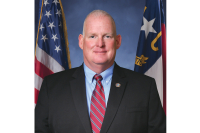Close encounters: Boaters at odds with those who don’t want Chattooga boating ban lifted
An age-old question has emerged in the raging debate over the Chattooga River wilderness: how many people is too many in the woods.
Paddlers have demanded the U.S. Forest Service lift a long-time ban on the upper Chattooga River outside Cashiers. Meanwhile, hikers, fishermen, backpackers and the like are fighting to defend the river’s sense of solitude from a perceived invasion of paddlers.
The forest service is wrestling with a decision, due out by the end of the year. A study sanctioned by the forest service was released last month weighing the potential impacts of paddling on the Wild and Scenic River corridor.
The study purported to look at the impact paddlers would have on other outdoor users, but it failed to actually survey people on the ground about their opinions and lacks a definitive verdict on whether the presence of paddlers would degrade the experience of others.
According to Mike Bamford of Cashiers, it most definitely would.
“Like keeping ATV’s limited to a few trails for others to also enjoy the forest, some creeks should be managed so that non-boaters can also enjoy these places,” Bamford said.
Ellie Hogan of Highlands thinks so, too. Every year, Hogan undertakes a ritual swim up a fast moving section of the Chattooga bordered by tall cliffs on both sides, the canyon-like walls dripping with moss and ferns. Hogan’s been doing the swim for 33 years.
“If I can do that I know I’m good,” Hogan said.
Kayaks shooting through the canyon would ruin Hogan’s remote experience, though.
Of course, that’s the same remote experience that kayakers like Don Piper would like a chance to experience. Just as much as any hiker or backpacker, Piper wants a wilderness trip where he doesn’t see any other people, but his preferred mode of recreation is kayak. He likes to put in at dawn to ensure a more remote experience.
Piper doesn’t understand the strong aversion to paddlers expressed by some of the opponents. They can’t seem to tolerate even the idea of a paddler on the river.
“I think there is a real misconception of what paddlers really are,” Piper said.
Tom Hession of Franklin, a jack-of-all-trades when it comes to outdoor recreation, said the so-called aversion to paddlers is being propagated by a few advocates.
“This conflict has been beefed up to the point of being ridiculous by people who don’t want boaters,” said Hession, a self-described hiker, fisherman, camper, and swimmer, as well as paddler.
Hession doesn’t think the average outdoor user along the Chattooga will mind seeing a few paddlers, at least not based on what he’s seen elsewhere.
“People hiking or on horseback will stop and watch you go over a rapid,” Hession said. “It’s a freaking Olympic sport. Obviously people like to watch it.”
Survey has critics
Forest service officials said the impacts of paddlers on other forms of recreation will be taken into consideration when making a decision. Unfortunately, the forest service doesn’t know what the tolerance level toward paddlers is, since the study didn’t include surveys of average outdoor users on the ground in the Chattooga corridor.
Doug Whitaker, a consultant hired to conduct the study, said such a survey would have been problematic.
“We would have to ask people to evaluate a hypothetical. They would have to invent what they think boating is like, which they can’t do because there is not that use out there,” Whitaker said.
Bamford disagreed.
“Every other river has boaters. It’s not like people only go to the Chattooga to hike. They can easily tell you what their level of tolerance is with boaters,” said Bamford.
Bamford said there’s not enough data on the types of users on the Chattooga period, let alone how those users might feel about paddlers.
“You need to know how may people use the river now. Without the baseline information on the birders, the hikers, the swimmers, how do you determine what the impact is going to be on those users?” Bamford asked.
Mark Singleton, the executive director of American Whitewater, agreed with Bamford that the study is lacking.
“I am outraged the forest service has spent $1 million so far on this process and collected so little data,” Singleton said.
The study concedes that there is not enough data to evaluate the tolerance level of current outdoor users on the Chattooga toward paddlers.
“Without a recent user survey of Upper Chattooga users, assessing the relative number and effects of different types of encounters is challenging,” the study states.
Singleton believes the forest service should have opened the river to paddling for a limited period of time to document the actual reaction of other outdoor users to the paddlers. Singleton said users might be surprised to find paddling doesn’t bother them as much as they thought it would. Singleton cited a National Park Service study five years ago along the lower Chattooga where boating is allowed.
“When they spoke with hikers about their encounters with boaters, what they found is encounters with boaters actually enhanced their experience. Being able to view boating while hiking added to their experience. It didn’t detract from it,” Singleton said.
Sharing the river
Whitaker said there are two different types of conflict at play: those who don’t want to see the paddler and those who don’t like the idea of a paddler being on the river period, regardless if they never see that paddler.
“There are some that have a fundamental conflict in values and feel like a certain use is inappropriate in a certain place,” Whitaker said.
Whitaker said the conflict between recreation groups on the Chattooga is “asymmetrical.” Hikers, fishermen, and the like object to the presence of paddlers. But paddlers don’t seem to share a similar loathing for the other users.
“That allows one group to say ‘Hey, why don’t we just share?’” Whitaker said. That’s exactly the line that paddlers are using. But since paddlers aren’t bothered by the presence of other recreation groups, they aren’t “losing anything by sharing,” Whitaker said.
Whitaker said it is difficult to predict how often encounters between paddlers and other outdoor users would actually occur. Not every hiker in the Chattooga would see every paddler going by, Whitaker said. Trails do not have continuous views of the river, at times veering away from the river shore altogether.
“Boaters might go by hikers without hikers every seeing them,” Whitaker said.
The more likely encounters will be when hikers stop to picnic or sunbathe on rocks along the river, explore waterfalls or swimming holes. But that’s already the case, regardless of the presence of boaters, Whitaker said.
“We find there are geographic bottlenecks. There is either a cool swimming hole or a cool waterfall that people want to be close to,” Whitaker said.
Whitaker said there’s one thing to be thankful for in this debate.
“There’s lots of good day hiking in this region. There’s lots of good places for fishing. There’s lots of good places for whitewater boating. By no means is this the only place to do any of those things,” Whitaker said. “Having said that, almost everybody considers the Chattooga a very special place.”
To boaters, the issue of too many people in the wilderness shouldn’t be solved by singling out one form of recreation and banning it.
“It should be open to everybody,” said Robin Hitch of Cullowhee, a computer consultant.
Hession said boaters have been mischaracterized as ruinous to the environment. But according to the recent study, the Chattooga River corridor is trampled with unofficial trails leading to fishing holes and campsites, and trash piles are common.
“How can they claim we’re going to do that when it is happening without us there?” Hession asked.
Singleton said the Wild and Scenic River corridor is in dire need of better management.
“Currently the only management practice in place is to ban boating,” Singleton said. “There are camp sites too close to the river. Trash far exceeds the amount of trash you would find in other Wild and Scenic River corridors nationally. None of that is being managed. For us, what started as an access issue has really turned into something much more.”
Special-interest influence
Opponents fear the forest service is kowtowing to a small minority of outdoor recreation users and is being swayed by paddling lobbyist groups in Washington, D.C.
“I don’t understand why a small group of people can impose this,” said Amy Chase of Cashiers.
But paddlers don’t trust the forest service to be objective either. The forest service was forced into studying the issue only after a lengthy challenge of the ban by paddling groups.
“That leaves neither side with any confidence that there is a neutral analysis taking place,” Singleton said.
There seems to be one more thing everyone can agree on.
“It is going to be hard to come up with a win-win-win solution in this river corridor,” said Whitaker.









